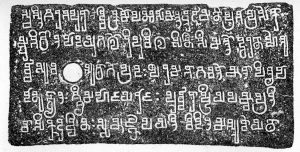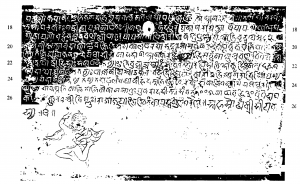Harsōlā Copper-plate Grant of Sīyaka (Grant A)
The charter on which this grant is incised (with its companion grant OB060015) consists of two plates. The descriptive metadata is given in Trivedi (1978).
IN03107 Oruvaḷa Sannasa
The sannasa (land grant) is engraved on both sides an oblong copper-plate. There are fifteen lines of text on the observe and a further fifteen lines on the reverse. Writing in the late 1920s, Codrington recorded that the plate “has for many years been in the possession of Mr W. P. Ranasinha, Notary Public”. The latter’s son – A.G. Ranasinha Esq., C.M.G., C.B.E. – lent it to an exhibition organised by the Historical Manuscripts Commission in 1952.
The sannasa records a grant of land to two Brahmans – one Potā Ojjhalun and his nephew Avuhaḷa Ojjhalun of the Śān̆ḍiḷya gotra. As the sannasa relates, these Brahmans served as chief purohita “until His Majesty our King Mahā Parākrama Bāhu…had worn the crown fifty-five times” (i.e. had reigned for fifty-five years). Kings of this period wore the state crown every year on the anniversary of their coronation, hence a king who wore the crown fifty-five times must have reigned for fifty-five years. In recognition of their service, the Brahmans received for their maintenance the village of Oruvaḷa in Aturugiri Kōralē. Subsequently another king made this village a perpetual dānakṣetra in favour of the nephew and also granted him another village in the neighbourhood. Avuhaḷa Ojjhalun, not content, applied either to the same king or to one of his successors for a copper-plate charter confirming that the land held by him was permanently declared a dānakṣetra subject to an annual payment of fifteen fanams to the god Vishṇu. In answer to this request, the present sannasa was issued by king Siri San̆gabo Śrī Parākrama Bāhu at Jayavarddhanapura Kōṭṭē in the fourth year of his reign.
Codrington identifies Mahā Parākrama Bāhu – the king served by the two Bhamans – as Parākrama Bāhu VI, who reigned from 1412 (or 1415, according to certain historical sources) until 1467 A.D. However, the identity of Siri San̆gabo Śrī Parākrama Bāhu – the king who issued the sannasa – is less certain. Kings Parākrama Bāhu VII, VIII and IX are all possibilities, although it is most likely to have been one of the first two. On palaeographic grounds, Codrington favours Parākrama Bāhu VIII. Oruvaḷa (Oruwala), the village mentioned in the grant, is situated near Aturugiriya, about three miles south-south-west of Nawagamuwa.
IN01012 Arang Charter of Jayaraja

Arang Charter of Jayarāja, first plate
Kondamudi Charter of Jayavarman, year 10
This set of 8 copper plates were discovered in the village of Kondamudi and were secured together with a ring and seal. The seal is stamped with an image of a trident, a box, a crescent moon and a circular legend which is written in different characters to those found on the copper plates.
The charter records that Mahārāja Jayavarman donated the village of Pāṇṭūra in the district of Kūdūra to 8 Brāhmaṇas. The donated village was split into 24 shares and divided between the Brāhmaṇas as follows:
Śarvaguptārya, a householder of the Gautama gotra – 8 shares
Savigija of the Tānavya gōtra – 3 shares
Goginaja – 3 shares
Bhavannaja of the Kauṇinya gōtra – 2 shares
Rudavennhuja of the Bhāradvāja gōtra – 1 ½ shares
Tśvaradattārya of the Kārshṇāyana gōtra – 1 ½ shares
Rudaghōshārya of the Aupamanyava gōtra – 1 share
Skandarudrārya of the Kauśika gōtra – ½ share
(This division does not total 24 shares however).
The charter was issued from Kūdūra on the 1st day of the 1st fortnight of winter in the 10th year of Jayavarman’s reign. The donated village was made as brahmadēya and Jayavarman is described in the inscription as belonging to the Bṛhatphalāyana gōtra and a worshipper of Mahēśvara, a form of Śiva. The donation was made to increase the donor’s life span and to secure victory in war.
Sircar, Altekar and Majumdar date Jayavarma’s reign to around the end of the 3rd century and the beginning of the 4th century AD, suggesting he was a contemporary of the early Gupta kings.
Maṭṭepād Charter of Dāmōdaravarman, year 2
This set of 5 copper plates was found in the village of Maṭṭepād in the Ongole region of the Guṇṭur district. The plates were sent to Rao Bahadur H. Krishna Sastri by the Tahsildar of Nellore. The plates are secured together with a ring and a seal which is worn.
The charter records the donation of the village of Kaṅgūra by Dāmōdaravarman. The donated village was divided into 18 parts and each part was given to a named Brāhmaṇa: Koṇḍinna Ruddajja, Koṇḍinna Nandijja, Koṇḍinna Khandajja, Koṇḍinna Bhavajja, Koṇḍinna Aggijja, Koṇḍinna Śryārya, Koṇḍinna Bhavajja, Koṇḍinna Khandajja, Koṇḍinna Savarajja, Koṇḍinna Aggijja, Koṇḍinna Virajja, Uassava Dāmajja, Uassava Kumārajja, Uassava Veṇujja, Uassava Devajja, Kāśyapa Nandijja, Vatsa Doṇajja, and Āgasti Bhaddajja.
The charter was issued from Kandarapura on the 13th day of the bright fortnight of Kārttika in the 2nd year of Dāmōdaravarman’s reign. Within the inscription Dāmōdaravarman is described as belonging to the Ānanda gōtra and who meditated at the feet of Samyak-Saṁbuddha.
Gōraṇṭla Charter of Attivarmā
This set of three copper plates were acquired by Walter Elliot from Sōmasundara Mudaliyār of Gōraṇṭla. The plates are secured together with a ring and seal, the design of which is indistinct.
The charter records the donation of the village Antukkūr and field, referred to as Ashṭaśata-patti in the village of Tānthikontha, which was located on the south bank of the river Kṛshṇabeṇṇā. The donated village and land was given to the Brāhmaṇa Koṭṭiśarmā of the Kāśyapa gōtra who knew the Āpastambha sutra.
Within the inscription Attivarmā is described as a descendant of the great saint Ānanda. The inscription does not contain a date.
EIAD162 Dhārikāṭūra Charter of Achaṇḍavarman
This set of four plates was first published in June 1954 after it was sent to the office of the Government Epigraphists for India by Shri M. Somasekhara Sarma of Madras. The location of its discovery is not known.
The charter records the donation of the village of Dhārikāṭūra as an agrahāra by Achaṇḍavarman who is refered to by the title Yuvamahārāja which Sircar translates as ‘crown prince’. The donated village was given to two Brāhmaṇa brothers Bhavaskandaśamārya and Bhartṛiśarmārya who belonged to the Bhemāṇa-Kāśyapa and resided in Donṇṇampi.
The charter was issued from Vēṅgīpura, which has been identified as the modern village of Pedavegi, on the 3rd day of the 6th fortnight of the rainy season in the 35th year. The year of the issue probably refers to the reign period of an unnamed king if we follow Sircar’s argument that Achaṇḍavarman was a crown prince.
EIAD167 Kānukollu Charter of Skandavarman, year 1
This set of four copper plates was unearthed alongside a second Śālaṅkāyana copper plate in the village of Kānukollu, Guḍivāḍa taluk in 1940. The copper plates were found in the earth near the ramparts of an old fort, gold and lead coins have also been found in the same location.
The plates were originally secured together with a ring and seal, which was melted down shortly after the charters discovery.
The charter records the donation of the village of Kompara in Kudarāhāra district to the Chāturvaidya community who resided in Rathakāra. The grant is described as a Brahmadeya, suggesting that Chāturvaidya was a religious institution.
The charter was issued from Vēṅgīpura, which has been identified as the modern village of Pedavegi. The charter was issued on the 1st day of the bright fortnight of the month of Kārttika in the 1st year of Skandavarman’s reign.
The inscription states that Skandavarman was a worshipped of Chitrarathasvāmin and was the son of Hastivarman, the grandson of Nandivarman and the great-grandson of the Hastivarman.
EIAD161 Kānukollu Charter of Nandivarman, year 14
This set of 8 copper plates was unearthed alongside a second Śālaṅkāyana copper plate in the village of Kānukollu, Guḍivāḍa taluk in 1940. The copper plates were found in the earth near the ramparts of an old fort, gold and lead coins have also been found in the same location.
The plates are secured together with a ring and seal and the chart records the donation of the village of Piḍiha by Nandivarman to the Chāturvaidya community in Rathakāra. The donation was made to increase the spiritual merit of Nandivarman and to increase the fame of Bālakamahārāja-kumāra Khaṁdapotta.
The charter was issued from Vēṅgīpura, which has been identified as the modern village of Pedavegi on the 1st day of the 2nd fortnight of the rainy season in the 14th year of Nandivarman’s reign.
Krishna Rao 1955-56 argues that this charter was issued by Nandivarman I and is not the same Nandivarman of the Pedavegi copper plate.
EIAD165 Kollair/Kolleru Charter of Nandivarman II, year 8
This set of four copper plates records the donation of the village of Vidēnūrapallikā in Kuḍuhāra to 150 Brāhmaṇas of various gōtras and charaṇas who lived in the agrahāra village of Kuravaka. The donation was made by Nandivarman and was issued from Vēṅgīpura, which has been identified as the modern village of Pedavegi.
The charter is dated to the 8th day of the dark fortnight of Paush in the 7th year of Nandivarman’s reign.
Within the inscription Nandivarman is described as the eldest son of Chaṇḍavarman.

